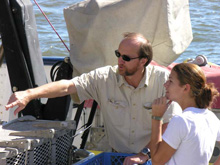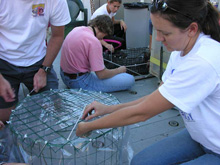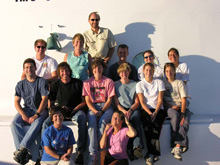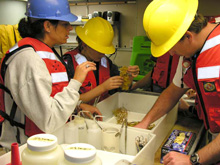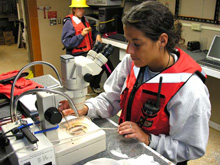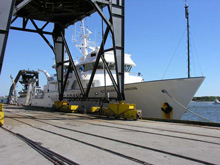
The R/V SEWARD JOHNSON docked at Morehead City, NC. Click image for larger view and image credit.
Dr. Ross and his student Jennie McClain. Click image for larger view and image credit.
Net Results
October 16, 2005
Bob Schwartz
Web Coordinator
NOAA Public Affairs
![]() The first Neuston net sample was collected off Cape Loookout, NC, an area where the team has worked extensively in the past.
The first Neuston net sample was collected off Cape Loookout, NC, an area where the team has worked extensively in the past.
(Quicktime, 1.1 Mb.)
After months of preparation and perspiration, Life on the Edge 2005 is officially underway. Under clear skies and with the best weather we could have hoped for, the R/V SEWARD JOHNSON, with its 19-member crew and 15-member science/education team departed the State Port at Morehead City, NC and began the 6-hour steam towards its first objective site off Cape Lookout, NC.
Onboard operations among the science team, however, began well before the ship left the port. When the science team arrived at noon today, they wasted no time unloading gear, setting up their equipment in the ship’s wet and dry labs, and setting off to work.
In the shadow of the larger-than-it-looks-in-pictures Johnson Sea-Link submersible locked down on the main deck, members of the science team began fabricating accessories for the sub…out of wire lawn fence and plastic shower curtains. Among the scientists was Melissa Partyka, a member of Dr. Ross’s team. She built a cylindrical holding area, about two feet in diameter, which will be used at depth to trap fish so that the sub crew has a better chance of catching targeted fish samples using the much narrower suction tube. “It has just as much a chance of not working as it does of working,” she said. And at what cost? “About six bucks” she said.
This is much more than mere underwater basket weaving. “We spend ungodly amounts of time, which is money, down there chasing fish and a six-dollar trap may mean the difference between catching it or not,” explains Principal Investigator Dr. Steve Ross. “Actually catching the fish allows us to identify it much more accurately than if we’re just looking at it on video,” he said.
Experimental prototypes like these traps can lead to process and equipment improvements, and usually only come about as the brainchild of experience. A similar, low-cost enhancement being employed on this trip is to paint the white, 5-gallon collection buckets black. Attached to the front of the sub, these buckets serve as containers for the various samples collected at depth. In previous expeditions, when the sub’s cameras followed the manipulator arm as it moved the sample from the dark reef environment, the large white bucket caused an undesirable glare in the video image when it came into frame. Painting it black should alleviate that problem and allow for undisturbed video documentation.
Shortly following dinner, a group photo, and safety demonstrations, Dr. Ross conducted our first science meeting in the dry lab. Forgiving the matching red knit caps we all wore and the hot pink water wings donned by Dr. Ross during a short safety lecture, the meeting was all business. Dr. Ross made it clear that this will be a 24-hour operation. “There is never too much data recorded, only too little,” he said. Topics discussed included Neuston net sampling operations, which would be led by Tara Casazza shortly following the meeting, and preparations for the first submersible dive, which is scheduled promptly at 8AM tomorrow morning.
This expedition will build on discoveries made and data collected on previous Life on the Edge cruises, so it made sense that the first Neuston net sample was collected off Cape Loookout, NC, an area where the team has worked extensively in the past. Sampling tows began at approximately 11:30PM. After the net was deployed and towed for 15 minutes, Tara and her night team, all of whom had already been working since early this morning, eagerly pulled in the first sample and brought it into the wet lab. Not pausing to remove hard hats and life jackets, the team went through the sample and began separating and storing the contents.
Dr. Ross inspected the sample, which included sargassum and its endemic fauna, as well as estuarine grasses that may have been swept up the gulf stream from as far as Florida. The ship circled around this area, which is the site for the first submersible dive, and Neuston net tows were conducted continuously throughout the night. Subsequent samples included many larval eels, one of the priority targets, making the first night’s sampling very successful.
Please check back frequently for more logs as the expedition unfolds.
Sign up for the Ocean Explorer E-mail Update List.


























